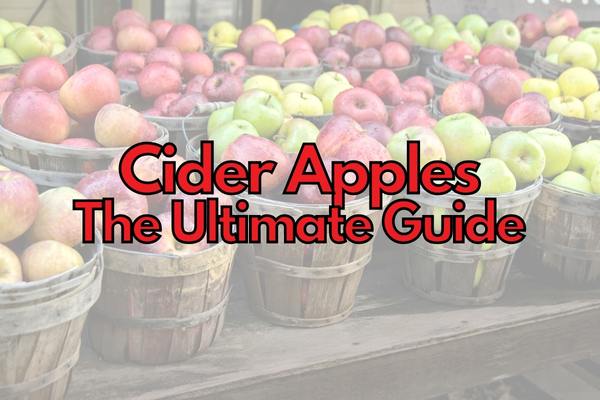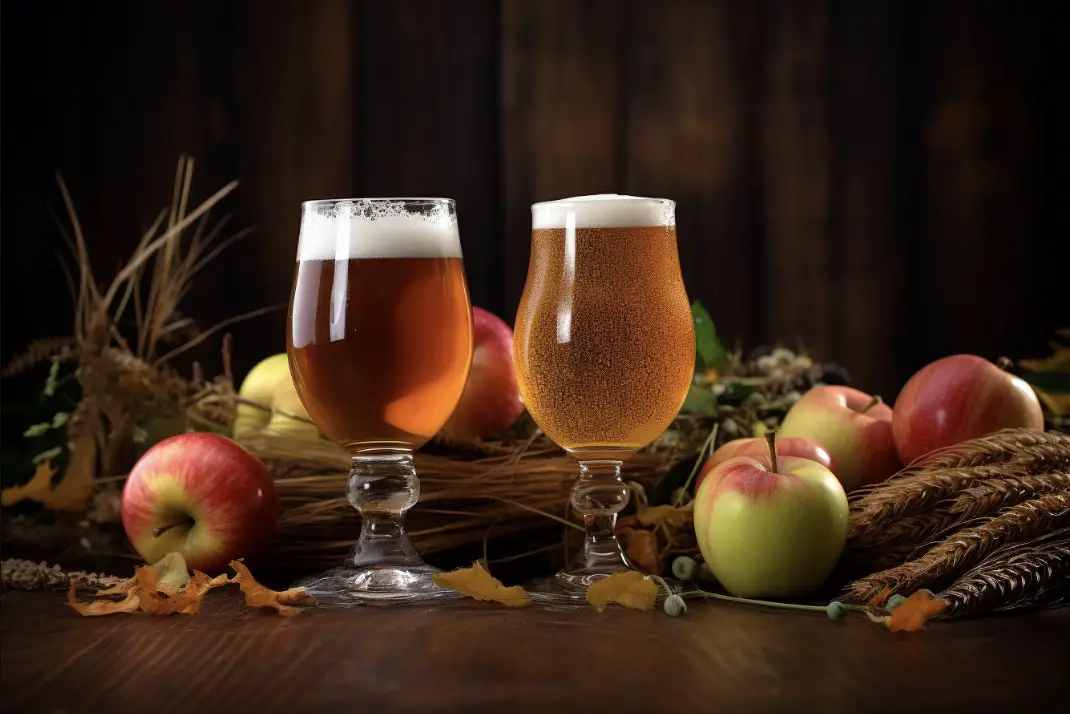Cider apples are different from those we eat. They are higher in tannins and acidity, which gives cider its characteristic astringency.
The best cider apples will have a balance of sweetness and acidity, with just enough tannin to give the cider body and structure. English cider apples are typically made with bittersweet or sharp apples, such as Kingston Black, Dabinett, or Yarlington Mill.
French and Spanish ciders are also made preferably with astringent and tannic apples, but some Spanish ciders can be very acidic as well!
These varieties have high levels of tannin and acidity, which give the finished cider a dry finish without being too harsh.

These varieties add sweetness and roundness to the final product without making it cloying.
Of course the perfect cider apples to use depends on your taste and what you want to achieve with your cider. Some apples are better for light refreshing ciders, while other gives you a deep beer-like cider.
How Are Cider Apples Different From Those We Eat?
While regular apples you get at the grocery store are great for eating and cooking, they aren’t necessarily the best type of apple for cider brewing.
Cider apples have bitterness, tannins and acid that, when the sugar is fermented, gives a fuller body to the finished product.
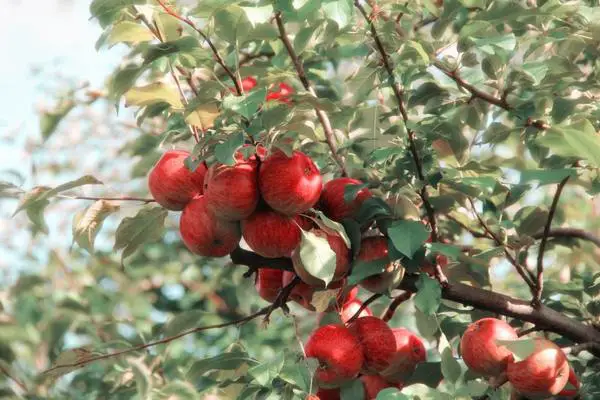
Tannins are compounds found naturally in plants, including fruit skins, which give cider its dryness and astringency.
Tannin content varies greatly among varieties of cider apples; some may contain as much as 10 times more tannin than others! The presence of these compounds also helps to preserve the drink for longer periods of time.
Other differences include:
- The skin of a cider apple is thicker than that of a regular apple – this helps add astringency and flavor to your final brew.
- The flesh of a cider apple is lower in water content but higher in sugars – this means that more fermentable sugars are extracted during the crushing process which results in a higher alcohol content once fermentation has occurred.
- Cider apples also contain different natural yeasts on their surface – while not essential, these can help kickstart an interesting direction of fermentation if you’re not using commercial yeast strains.
- The high acidity levels in cider apples will also contribute to the tartness of your finished cider.
Acid profiles also vary between eating and cider apples, with most having higher acidity levels than their counterparts used for consumption purposes. Acids such as malic acid provide tartness to the finished product while lactic acid can contribute complexity to it’s flavor profile when fermented correctly.
The sweetness level of hard ciders depends on the type of apple used during production; certain varieties like Golden Delicious will yield sweeter drinks while others like Kingston Black will produce drier ones due to their low sugar content.
In addition, some producers add additional sugars during fermentation to further enhance sweetness levels if desired by consumers.
In conclusion, there are several differences between eating and cider apples that make them suitable for use in hard ciders.
These include higher tannin content which provides dryness and astringency; increased acidity which adds tartness; lower sugar yields resulting in drier drinks; and additional sugars can be added during fermentation to provide extra sweetness if desired by drinkers. All of these factors contribute to an enjoyable beverage with unique flavors.
So, if you’re looking to make a delicious hard cider at home, be sure to source some quality cider apples – your taste buds will thank you!
Key Takeaway: Cider apples have thicker skin, lower water content, and higher sugar content than regular apples – this makes for a tastier hard cider.
Characteristics of Cider Apples
When it comes to brewing hard cider, the type of apple you use is important. The best hard cider has a complex blend of three elements:
Acidity, sugar, and tannins. Let me explain what each of these terms mean for making hard cider.
If you’ve ever bitten into a sour apple, you know that some apples have more of a sharp bite than others. The more acid apples have, the longer the oxidation process takes.
So these apples won’t turn brown as fast, and the finished cider will stay light in color.
On the other hand, sweet apples have less acidity. These apples will oxidize quickly, resulting in a cider that is dark in color.
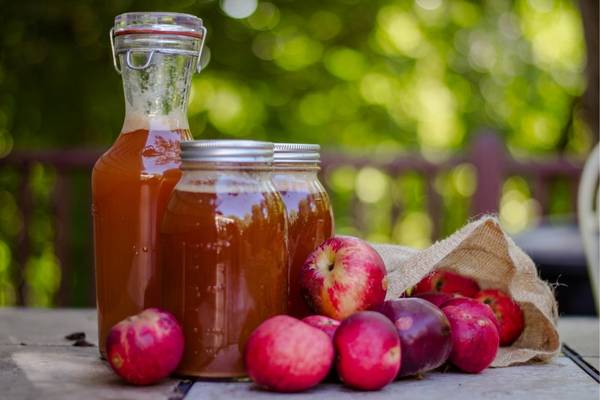
Tannins are what give cider its astringent taste. They are found in the skins and seeds of apples, and they contribute to the dryness of cider.
The more tannins an apple has, the more dry and harsh the cider will be.
So, what types of apples are best for cider brewing? A good hard cider has a balance of all three elements.
That means you need to use a mix of apples in your cider, including both sour and sweet varieties.
For the acidity, you can use apples such as Granny Smith, Honeycrisp, or Braeburn. For the sugar, use apples such as Golden Delicious, Rome, or Fuji.
And for the tannins, use apples such as Jonathan Apples, Winesap, or Newtown Pippin.
By using a mix of these apples, you’ll create a hard cider that is well-rounded and complex. So don’t be afraid to experiment with different types of apples to find the perfect blend for your cider.
Acids in Cider Apples
Acids in cider apples are an important factor when it comes to creating a balanced and flavorful hard cider. Different types of apples have different levels of acidity, which can affect the flavor and mouthfeel of the finished product.
The most common acids found in hard cider are malic, citric, tartaric, succinic and lactic acids. The amount depends on the apples used and the brewing process.
Malic acid is responsible for the sharp acidity and tartness in cider apples. The higher the level of malic acid, the more tart the apple will taste.
Citric acid adds a soft citrusy note while tartaric acid contributes to the overall sourness of the beverage. Succinic acid provides a subtle acidity while lactic acid lends a creamy, more rounded sourness and texture to the drink.
Malic acid is the most abundant acid found in apple juice and gives it its characteristic tartness. It is fairly sharp and can be too dominant if left alone without much sweetness.
This is why many cider makers perform a so-called malolactic fermentation to convert malic acid into lactic acid – to soften up the taste a bit.
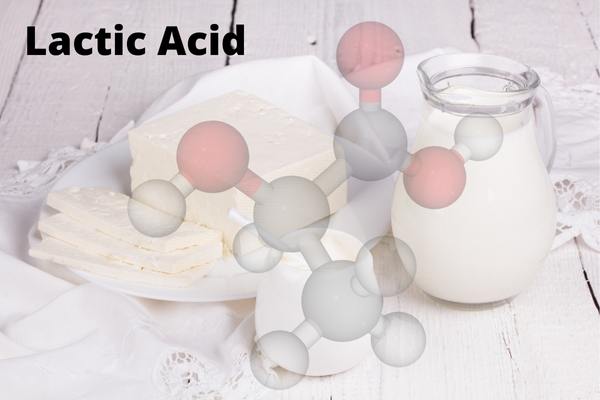
Different types of apples contain different levels of acids. Cider apples tend to have higher levels of acids than other types of apples.
The three main acids found in cider apples are malic acid, citric acid, and ascorbic acid.
Citric acid gives cider apples a fresh, tangy flavor. The higher the level of citric acid, the more tangy the apple will taste.
Ascorbic acid is present at lower levels and is a vitamin (vitamin C!) and a souring agent. The higher the level of ascorbic acid, the more sour the apple will taste.
The acid levels in cider apples can vary depending on the type of apple and where it was grown. So, when you’re choosing apples for cider brewing, it’s important to consider the acid levels.
It’s also important to remember that some apple varieties contain naturally high levels of tannins which, along with acids, can add a strong sense of astringency and dryness when fermented into alcohol.
So these apples should be controlled well, unless desired by preference since they cannot easily be removed after fermentation has occurred without diluting them out with additional water or sweetener like honey or sugar syrup depending on what kind of end result you’re trying achieve from your batch size/recipe design process.
The selected yeast strain will play a significant role in the acid profile of the finished cider as the metabolism of the yeast changes and adds to the acids present in the cider.
The best apples for cider brewing are those that have a balance of different acids. This will give your cider a complex flavor that is both tart and tangy.
Tannins in Cider Apples
Tannins are bitter-tasting compounds that occur naturally in plants. They’re found in the skins, seeds, and leaves of fruits and vegetables, as well as in tea and red wine.
Tannins give cider its astringent taste and contribute to its bitter flavor. They also help preserve it by preventing bacteria from growing.
While tannins can add complexity and depth of flavor to cider, too much of them can make it taste harsh and unpalatable.
Cider apples are higher in tannin content than regular eating apples, making them ideal for producing flavorful ciders with good body and structure.
English cider apples have higher levels of tannin than other varieties, giving them a more bitter taste with notes of leather and tobacco.
The most common English varieties include Kingston Black, Dabinett, Foxwhelp, Yarlington Mill and Brown Snout. These apples tend to be high in acidity as well as tannin content, making them ideal for creating complex flavors in ciders when blended together with other types of apples or fruits like pears or berries.
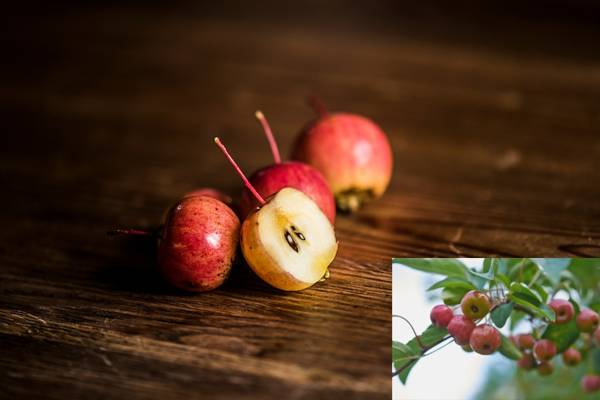
French cider apples typically have lower levels of tannin than their English counterparts but still provide enough structure to create a balanced flavor profile in ciders made from these varieties alone or blended with others.
Common French varieties include Binet Rouge, Muscadet de Dieppe and Petit Jaune Noir among many others. These apples usually have higher sugar content than English ones so they can add sweetness to the finished product without overpowering it with too much bitterness from excessive amounts of tannins.
Spanish cider apples are known for having low levels of both acidity and tannin but still providing plenty of flavor complexity due to their unique aroma profiles derived from terpenes present within each variety’s skin cells such as linalool found in Reineta Blanca Asturiana or geraniol found in Remolinos Gallegos Negros amongst many others native Spanish cultivars available today across Europe’s Iberian Peninsula region .
Finally, it is important to note that while some people may prefer sweeter ciders made using low-tannin apple varieties such as Golden Delicious, Gala and Braeburn.
Others may enjoy drier styles created by blending different types together including those containing higher amounts of this polyphenol compound such as traditional English bittersharp blends featuring Kingston Black alongside Dabinett.
Ultimately though, it all comes down to personal preference so experiment until you find what works best for your own individual tastes.
The Role of Astringency in Cider Apples
Astringency is an important characteristic of cider apples, and it can affect the flavor and mouthfeel of a finished cider. Astringency is caused by tannins in the apple skin, which are naturally occurring compounds that give apples their bitter taste.

The amount of astringency in a particular variety of apple will depend on its tannin content. Apples with higher levels of tannins tend to be more astringent than those with lower levels.
Tannins and astringency goes hand in hand
Tannins are polyphenolic compounds found in many fruits, including apples. They have an astringent taste and can contribute to bitterness or dryness in ciders made from them. Tannin content varies widely among different varieties of apples.
Some have very low amounts while others may contain high concentrations. Generally speaking, English cider apples tend to have higher levels than French or Spanish varieties, although there are exceptions to this rule as well.
English Cider Apples
English cider apples typically contain higher levels of tannins than other types due to their long history as traditional cider-making ingredients in England’s climate and soil conditions over centuries past. Varieties such as Kingston Black, Dabinett and Brown Snout all possess significant amounts of these compounds which impart a distinctively dry finish when used for fermentation purposes today.
French Cider Apples
French cider apples also contain relatively high concentrations of tannins but not quite as much as their English counterparts do overall; however they still offer plenty enough for making flavorful ciders with good structure and complexity when blended together properly during production processes like keeving or barrel aging techniques employed by craft producers today who specialize in producing fine French-style ciders using only traditional methods passed down through generations before them dating back hundreds if not thousands years ago!
Spanish Cider Apples
Spanish varieties usually contain less tannin compared to both English & French ones due largely because Spain’s climate tends towards warmer temperatures year round resulting fewer phenols being produced within each individual fruit itself.
This means that they’re often best suited for sweeter styles rather than drier/more complex ones requiring larger amounts (i e – bittersharp) though there still exist several notable examples such Acidez Negra Blanca etc. These could make interesting additions depending upon desired outcome desired end product!
When it comes to cider brewing, astringency is an important factor to consider when choosing the right type of apple. Next, we will look at how acidity plays a role in cider apples.
The Role of Sugars and Sweetness in Cider Brewing
When it comes to cider brewing, the role of sugars and sweetness is essential for creating a balanced flavor. Sweetness helps to offset the acidity and tannins in apples, contributing to an overall pleasant taste. The main sugar found in apples is fructose, which gives cider its signature sweet flavor.
The amount of sugar present in apples varies depending on their variety and ripeness. For example, English cider apples such as Kingston Black or Dabinett tend to have higher levels of sugar than French varieties like Binet Rouge or Muscadet de Dieppe.
In addition to fructose, some apple varieties also contain other types of sugars including glucose and sucrose. These can contribute additional sweetness but also add complexity to the flavor profile by providing subtle notes of caramel or honey when fermented into cider.
For home brewers looking for a sweeter tasting cider, adding extra sources of sugar can help achieve this goal without sacrificing quality or authenticity.

Honey is one popular option that adds a unique floral note while brown sugar provides a more traditional molasses-like flavor profile reminiscent of old-fashioned ciders from centuries past. Other ingredients like maple syrup can be used as well although these should be added sparingly so as not overpower the natural flavors from the apples themselves.
However, depending on the yeast strain used and the brewing technique used, higher sweetness can be achieved without adding additional sugars by keeving the cider during early primary fermentation or performing cold crashing of the cider later on.
Ultimately, understanding how different types of sugars interact with each other during fermentation can help you create your own unique recipes tailored specifically for your desired level of sweetness and complexity in the finished product.
The proper balance of sugars and sweetness is essential for a successful cider brewing experience, so it’s important to understand the different types of apples that can provide the desired flavor profile. Next, we’ll explore how to select the best apples for your cider brew.
Main Takeaway: The type of apples used for cider brewing can have a significant impact on the sweetness and complexity of the finished product. English, French, and Spanish varieties all contain different levels of fructose, glucose, sucrose, and tannins that contribute to their flavor profile. For home brewers looking for an extra sweet taste in their cider, adding additional sources of sugar such as honey or brown sugar can help achieve this goal without sacrificing quality or authenticity.
Cider Apple Categories
When it comes to brewing hard cider, the type of apple you use is important. Different types of apples offer different flavors and characteristics to your cider.
That’s why it’s important to know the different categories of cider apples and which ones are best for brewing.
There are two main systems for categorizing cider apples: the British system and the French system.
The British system is based on the taste of the apples, while the French system takes sugar content into account as well.
The British system has four categories: sharp, bittersharps, bittersweets, and sweets.
Sharp apples are high in acidity and low in sugar, while bittersharps are high in both acidity and tannins. Bittersweets are low in acidity but high in sugar, and sweets are low in both acidity and sugar.
The French system also has four categories: sweet, bittersweet, bitter, and acidic.
Sweet apples are high in sugar, bittersweet apples are high in both sugar and tannins, bitter apples are high in acidity, and acidic apples are high in acidity and low in sugar.
So, which types of apples are best for cider brewing? It depends on the style of cider you’re going for.
If you want a dry cider, you’ll want to use apples from the bittersweet or bittersharps categories. For a sweeter cider, apples from the sweet or acidic categories will work best.
And for a cider with more complex flavors, a mix of different types of apples from all of the categories is ideal.
No matter what type of cider you’re looking to brew, there’s a perfect type of apple out there for you. So get out there and start experimenting to find the perfect cider for your taste.
European Cider Varieties
While some of these varieties are more well-known than others, all of them have their own unique flavor profiles that can add something special to your cider.
The main categories in Europe are those originating from England, France or Spain, which I will go through in more detail below.
English Cider Apples
English cider apples are a special type of apple that have been used for centuries in the production of hard ciders. These apples are typically smaller and more tart than those we eat, with higher levels of tannins and acids. They come in many varieties, each offering unique flavors to the finished product.
The traditional English bittersweet cider apple is one of the most widely used varieties for making cider. It has a strong flavor profile with high levels of tannin and acidity that give it an intense astringency on the palate. Bittersweets also tend to be low in sugar content, which helps balance out their bolder characteristics when blended with other types of apples during fermentation.
Another popular variety is the English sharp or acidic cider apple, which offers a much different flavor profile than its bittersweet counterpart. Sharps have higher levels of acidity but lower levels of tannin, resulting in a crisp yet slightly sweet taste when fermented into hard cider.
The juice from these apples can also be blended with sweeter varieties to create complex ciders that still retain some level of sweetness on the finish without being overly cloying or syrupy-tasting like many mass-produced brands available today.
Finally, there is the classic English dessert or culinary cider apple. This type has less acidity and bitterness than either sharps or bittersweets, but contains higher amounts of sugars so it can ferment into sweeter styles if desired by adding additional yeast strains during fermentation process such as champagne yeast for sparkling ciders or ale yeasts for fuller bodied brews. Dessert apples are often combined with sharper varieties to create balanced blends that offer both complexity and drinkability at once.
English Cider Apples are renowned for their tart, sweet and tannic flavors that make them ideal for cider brewing. Next, we’ll explore the different types of English Cider Apples and how they can be used in cider making.
Main Takeaway: English cider apples come in a variety of types, each offering unique flavors to the finished product. Bittersweets are high in tannin and acidity, sharps have higher levels of acidity but lower levels of tannin, and dessert apples contain higher amounts of sugars for sweeter styles. Blending these different varieties can create complex ciders that offer both complexity and drinkability.
French Cider Apples
French Cider Apples are a unique variety of apple that is used to make cider. They have high levels of tannins, which give the cider its characteristic dryness. French Cider Apples also have a sweet flavor that helps to balance out the bitterness from the tannins.
The sweetness in French Cider Apples comes from their higher sugar content than other apples typically eaten as fruit. This makes them ideal for fermentation and gives them an edge over other types of apples when it comes to making cider.
Tannins are what give French Cider Apples their signature dryness and astringency. Tannins come from polyphenols, which are naturally occurring compounds found in plants like apples and grapes. These polyphenols interact with proteins in our saliva, giving us a drying sensation on our tongue when we consume them – this is why some wines can be described as “tannic” or “astringent” tasting!
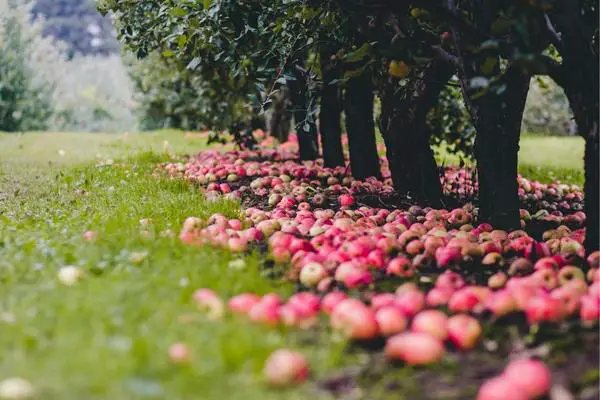
Acids play an important role in how cider tastes too; they help bring out the flavors of fruits like apples while balancing out any sweetness present in the drink itself. The most common acids found in French Cider Apples include malic acid (which provides tartness) and citric acid (which adds brightness). Other acids such as lactic acid may also be present depending on how long the juice has been fermented for – this can add complexity to your finished product!
Overall, French Cider Apples provide home brewers with a unique combination of tannin-rich dryness, balanced sweetness and complex acidity. These components are essential for creating delicious ciders at home. Through careful selection and preparation, these special varieties can enhance your homebrewing experience significantly.
French Cider Apples are renowned for their tart flavor and high tannin content, making them an excellent choice for cider brewing. Next, we’ll explore the benefits of English cider apples.
Main Takeaway: French Cider Apples are the perfect choice for cider brewing due to their high levels of tannins, sweetness and complex acidity. These components provide a unique flavor profile that is essential for creating delicious ciders at home. With careful selection and preparation, these special varieties can enhance your homebrewing experience significantly.
Spanish Cider Apples
Spanish Cider Apples are a special variety of apples used to make the classical non carbonated Spanish ciders. The most popular varieties include Raxao, Regona, Durona and Collaos apples. These types of apples have high levels of sugar and acidity which makes them ideal for cider brewing.
Raxao is an apple with a light yellow skin and sweet taste. It has low tannins but high acidity making it perfect for creating sparkling ciders that have a fresh flavor profile.
Regona is an apple with greenish-yellow skin and crisp texture when eaten raw, however its flavor changes significantly when fermented into cider as it becomes more mellow in taste while still maintaining some tartness due to its high acid content.
Durona is another type of Spanish Cider Apple that has dark red skin and sweet-tart flesh inside. Its sweetness comes from the fact that it contains higher amounts of fructose than other varieties, making it great for producing sweeter ciders without adding any additional sugars or honey during fermentation process.
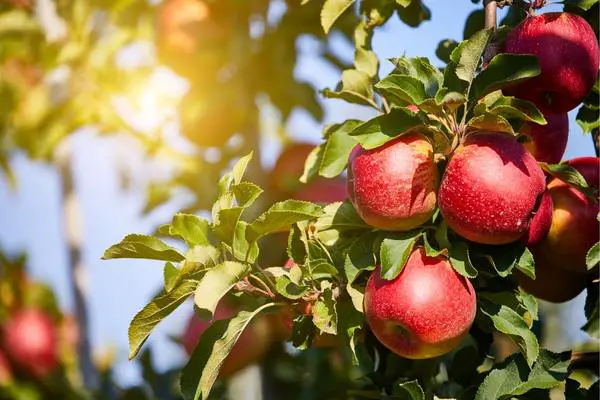
Collaos is an apple with yellowish-green skin and firm texture when eaten raw; however its flavor changes drastically after being fermented into cider as it produces notes of tropical fruits such as pineapple or mango along with hints of citrusy flavors like lemon or lime due to its higher amount of malic acid content compared to other varieties mentioned above.
Finally, Errezil is an especially aromatic variety often used in traditional Spanish ciders due to its intense floral aroma combined with subtle fruity notes such as pear or peach. This flavor can be further enhanced by aging the cider in oak barrels prior to bottling, if desired by the brewer.
Spanish cider apples are a great choice for making hard cider, as they have the perfect balance of acidity and sweetness. Next, we’ll look at English Cider Apples to explore which varieties work best for cider brewing.
Main Takeaway: Spanish Cider Apples are a special variety of apples used to make the classical non carbonated Spanish ciders. These types of apples have high levels of sugar and acidity which makes them ideal for cider brewing, with popular varieties including Raxao, Regona, Durona, Collaos and Errezil. Each type has its own unique flavor profile that can be further enhanced by aging in oak barrels prior to bottling.
Apples typically Used for Cider in North America
While there are many types of apples that can be used for cider brewing, there are some that are better than others.
In North America, there are many different types of apples that are used for cider brewing, including commercial dessert varieties, heirloom varieties, and true cider apples.
There are a variety of different apples that are used for apple cider in North America, such as popular desserts, traditional types, and real (or authentic) types.
So, what are the best apples for cider brewing in North America? Here are some of the most popular types of apples used for cider brewing in the United States and Canada:
- Granny Smith apples are a type of apple that is tart and acidic. They are one of the most popular types of apples used for cider brewing.
- Honeycrisp apples are a type of apple that is sweet and crisp. They are a popular type of apple used for cider brewing.
- Golden Delicious apples are a type of apple that is sweet and mellow. They are a popular type of apple used for cider brewing.
- Braeburn apples are a type of tart and sweet apples.
- Jonathan Apples are quite tart and crisp.
- Rome Apples are dense and sweet.
- Northern Spy apples are nice and tart but also crisp.
- Winesap apples are tart and aromatic.
- York Apples are tart and acidic.
- Calville Blanc apples are a type of is tart and acidic.
As you can see, there are many different types of apples that can be used for cider brewing. The type of apple you use will have a big impact on the flavor of your cider.
so be sure to choose the right type of apple for the flavor you want.
Best Cider Apples for Sharp-Sweet Cider
While there are many different types of apples that can be used for cider, the best apples for sharp or sharp-sweet cider are those that are high in acidity and low in tannins.
Granny Smith apples are one of the most popular types of cider apples due to their tart flesh and lime green skin. These apples are originally from Australia and are known for their excellent shelf life and storage capabilities.
Granny Smiths are also good for eating fresh and for cookingbaking in pies and cakes.
Another type of apple that is perfect for sharp cider is the Foxwhelp apple. These apples are small and round with a deep red skin.
They are incredibly tart and have very little flesh, which makes them ideal for cider brewing. Foxwhelps are also a good option for those who are looking for a cider apple that is easier to grow.
No matter what type of cider you are looking to make, there is an apple out there that will suit your needs. Do some research and find the perfect type of apple for your next batch of cider!
Best Cider Apples for Bittersharp Cider
Bitter-sharp apples are high in both acid and tannins, and while they can make delicious hard cider, it’s important to choose an apple that is also high in sugar.
Kingston Black is one very good apple for cider with a balanced bittersharp flavor. Originally an English variety, this heirloom apple makes one of the best single-variety ciders.
While it can be difficult to grow, the Kingston Black makes an aromatic cider that is hard to match.

Other good options for bittersharp cider apples include the Foxwhelp, Ashmead’s Kernel, and the Dabinett. Each of these apples will provide a slightly different flavor, so it’s important to experiment to see which you like best.
When it comes to making cider, the type of apple you use is important. Bitter-sharp apples are high in both acid and tannins, and while they can make delicious hard cider, it’s important to choose an apple that is also high in sugar.
Kingston Black is one very good option for cider with a balanced bittersharp flavor.
Best Cider Apples for Sweet Cider
As implied by the name, sweet cider apples are high in sugar, low in acid, and low in tannins. Many of these varieties are already common in your kitchen.

Sweet ciders produce a very dessert-like drink that is perfect for hot, spiced cider or mixing into an apple cider cocktail.
The Gala apple defeated the Red Delicious in 2018 for being the most popular apple.
Crisp and mildly sweet, the Gala is perfect for making sweet, mellow cider. Its mild flavor makes it perfect for combining with more strongly-flavored apples like Granny Smith and Arkansas Black.
While any apple can technically be used to make cider, some varieties are better suited for the task than others. If you’re looking to make a sweet cider, you’ll want to use apples that are high in sugar and low in acidity.
Gala apples are a great option for sweet cider, as they are both crisp and mildly sweet. Another benefit of using Gala apples is that their mild flavor makes them easy to combine with other, more strongly-flavored apples.
Which varieties of apples make the best bittersweet cider?
Some types of bittersweet apple are lower in acidity and higher in sugar than other types, making them ideal for making sweet, dessert-style hard apple cider.
These are some of the best apples for bittersweet apple cider.
An excellent bittersweet cider apple is the Dabinett.
This variety of apples has been found to have the same tannin levels as red wine. Not only that, but the variety is also incredibly easy to cultivate.
Dabinett apple trees are very resistant to apple scabs and cankers.
The Kingston Black is another excellent choice for bittersweet cider.
This apple is very high in tannins and has a strong astringent flavor. The Kingston Black is also known for being one of the easiest cider apples to grow.
Tolman Sweet Apple:
This apple is lower in acid than most other cider apples and has a very sweet flavor. The Tolman Sweet is also known for being one of the easiest cider apples to grow.
These are just a few of the best cider apple varieties for bittersweet cider. If you’re looking to make a dry or bittersweet cider, be sure to check out these apples.
Blending Rules of Thumb
When it comes to cider brewing, there are a few different ways that you can go about it. You can use all one type of apple, or you can mix and match different types to create your own unique blend.
If you’re looking to create a cider that is well-rounded and flavorful, then blending different types of apples is the way to go.

There are a few things to keep in mind when you’re blending apples for cider. The first is that you want to use a mix of sweet and tart apples.
This will help to create a cider that is not too sweet and not too tart. You also want to make sure that you use a mix of apples that have different flavors.
This will help to create a cider that is complex and interesting.
An while not everyone has fancy cider apple varyities availible, there are definetly options that are still accecible to most ordinary people, either as whole fruits or as juice.
Here are a few of our favorite apples that are not too hard to come around:
- Granny Smith Apples: These apples are sweet and acidic, which makes them good additions for cider brewing with high alcohol content. They will help to balance out the sweetness of the other apples in your blend.
- Honeycrisp Apples: These apples are sweet and crisp, and they make a great addition to any cider blend. They will add some sweetness and body to your cider.
- Braeburn Apples: These apples are a bit of a mix between sweet and tart, and they make a great addition to any cider blend. They will help to add some sweetness and acidity to your cider.
- Golden Delicious Apples: These apples are sweet and mellow, and they make a great addition to any cider blend. They will help to add some sweetness and good amount of body to your cider.
- Rome Apples: These apples are tart and acidic, and they make a great addition to any cider blend. They will help to add some acidity and depth of flavor to your cider.
Blending different types of apples is the best way to create a cider that is well-rounded and flavorful. Keep these tips in mind when you’re selecting apples for your next batch of cider!
Tips on choosing apples for your cider making?
There are in theory many different types of apples that can be used for cider brewing, but not all apples are created equal. In order to make the best cider possible, it is important to use the right type of apples.
The most important factor to consider when choosing apples for cider brewing is the sugar content. The sugar content will determine how much alcohol is in the final product.
The higher the sugar content, the higher the alcohol content will be. There are many different ways to measure the sugar content of apples, but the simplest way is to use a refractometer.
Once you have determined the sugar content of the apples, you can then choose the type of apple that you want to use.
There are many different kinds of apples, but the most popular types for cider brewing include the following:
- cortland
- crispin
- empire
- fuji
- granny smith
- honeycrip
- macoun
- red delicious
Each of these types of apples has a different flavor, so it is important to choose the type of apple that you think will taste the best in your cider.
Once you have chosen the type of apple that you want to use, the next step is to press the apples to extract the juice. This can be done with a cider press or a juicer.
If you are using a cider press, it is important to follow the manufacturer’s instructions to ensure that you are using the press correctly.
After the juice has been extracted from the apples, it is time to fermentation. This is the process that turns the sugar into alcohol.
There are many different ways to ferment cider, but the most popular method is to use a yeast starter. This is a culture of yeast that is used to start the fermentation process.
Once the cider has fermented, it is time to bottle and enjoy it.
Do Honeycrisp Apples Make Good Cider?
The short answer is yes, honeycrisp apples make excellent cider. They’re tart and crisp, and make a delicious sweet cider.
However, there are a few things to keep in mind when using honeycrisp apples for cider. First, because they’re so tart, you may want to add a bit more sugar to the cider to balance out the flavor.
Second, honeycrisp apples are fairly small, so you’ll need more of them to make the same amount of cider as you would with other types of apples.
Overall, honeycrisp apples are a great choice for cider brewing. They make a delicious, crisp cider that’s perfect for fall.
Just keep in mind that you may need to add a bit more sugar, and you’ll need more apples to make the same amount of cider as you would with other types of apples.
Do Macintosh Apples Make Good Cider?
The Macintosh apple is a popular choice for making apple cider because it is sweet, juicy, and flavorful. The flavor of the macintosh is familiar and well-liked by most people.
In addition to McIntosh apples, other good choices for cider brewing include Granny Smith apples, Honeycrisp apples, and Golden Delicious apples. Each of these apples provides a unique flavor that will contribute to the overall taste of the cider.
When choosing apples for cider brewing, it is important to select apples that are fresh and ripe. Apples that are overripe or beginning to rot will not produce good cider.
It is also important to use apples that have been harvested from pesticide-free trees.
If you are looking to make a delicious batch of cider, be sure to use McIntosh apples. With their balance of sweetness and tartness, McIntosh apples will give your cider a great flavor that everyone will enjoy.
Cider Apple FAQs
Can I use any apples for cider?
Yes, you can use any apples for cider. However, some varieties of apples are better suited to making hard cider than others. Apples with higher tannin levels and acidity will produce a more complex flavor profile in the finished product. Sweet apples may need additional sugar or other ingredients added during fermentation to achieve the desired alcohol content. Additionally, blending different types of apples can create unique flavors that would not be possible using just one variety alone.
Do you need special apples for cider?
Yes, special apples are needed for cider brewing. Cider apples have higher tannin and acid levels than regular eating apples, which gives the finished product a more complex flavor profile. The most common types of cider apples used in brewing are bittersweet and bittersharp varieties, as they provide the desired balance of sweetness and tartness. Additionally, some heirloom apple varieties can be used to create unique flavors in ciders. It is important to note that cider apples can be difficult to find in grocery stores, so home brewers may need to source them from specialty orchards.
What apples are cider apples?
Cider apples are a special type of apple that is specifically grown for cider production. These apples have higher levels of tannins and acidity than regular eating apples, which gives the finished cider a more complex flavor profile. Cider apples also contain high amounts of sugar, which helps with fermentation and creates a sweeter final product. Popular varieties include Kingston Black, Dabinett, Yarlington Mill, Brown Snout, Golden Russet and Foxwhelp.
Do Gala apples make good cider?
Yes, Gala apples can make good cider. Their sweet flavor and firm texture makes them a great choice for cider making. They are also high in tannins, which adds complexity to the final product. Additionally, they have enough acidity to provide balance and prevent the cider from becoming too sweet or cloying. With careful fermentation techniques, Gala apples can produce a delicious hard cider with plenty of body and character.
Are Granny Smith Apples Good for Cider?
Granny Smith apples are ok for a refreshing cider. These apples are known for their tart flesh and lime green skin, which give them a unique flavor that is a bit bland, but sweet and fresh.
Another option is to use a blend of different apples to create a more complex flavor. Use, for example crab apples that provide the missing tannins, foxwelp apples will add tannins and body.
These apples will give your cider a deepr taste and a more complex flavor.
How many apples do I need for 5 gallons of cider?
The type of apple you use for cider brewing is important, as different apples will provide different flavors. For a traditional English-style cider, the best apples to use are bittersweet or sharp varieties like Dabinett, Michelin, or Stoke Red.
If you’re looking for a more fruity cider, then sweet apples like Cox’s Orange Pippin or Grimes Golden are better choices. As a general rule of thumb, you’ll need around 40-60 pounds (18-27 kg) of apples per 5 gallons (19 L) batch of cider.
Conclusion
Overall, the best apples for cider brewing are those that have a balance of sweetness and acidity. English ciders are typically made with bittersweet or sharp apples, while French ciders tend to be made with sweet apples.
Spanish ciders usually use a mix of both sour and tart varieties – and they often make still cider rather than carbonated cider!
If you’re looking for the best apples to use for cider brewing, look no further! English, French and Spanish ciders traditionally use a variety of different apples, each with their own unique flavor profile.
Tannins add astringency and body to the cider, while acidity balances out the sweetness. With so many different flavors to choose from, you’re sure to find the perfect apple (or mix of apples) for your next batch of cider!

